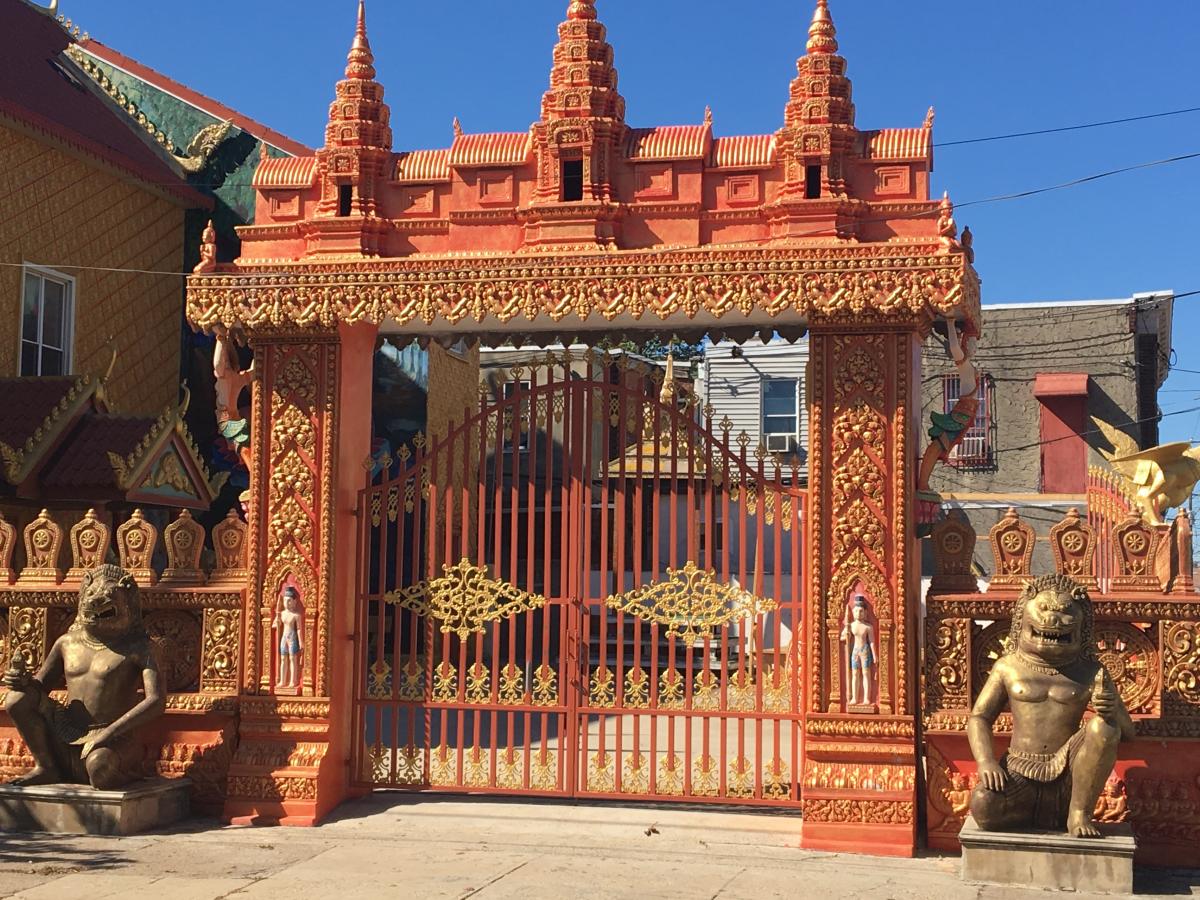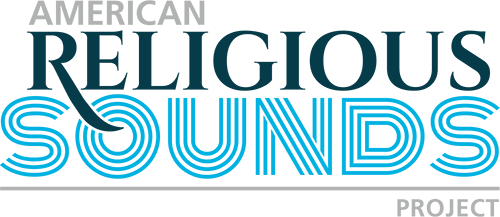Buddhism in Greater Philadelphia
by C. Pierce Salguero
Pierce Salguero is an ARSP site coordinator studying the sounds of Buddhism in Philadelphia. He is also the director of the Jivaka Project Philadelphia, a multimedia ethnographic project exploring the role of Buddhist institutions, practices, and cultural orientations in the American healthcare landscape between 2015 and 2020.
In the twenty-first century, as a result both of rising Asian immigration and the increasing popularity of Buddhism among non-Asian Americans, the city of Philadelphia has become a significant hub of American Buddhism. Buddhism has been present in Philadelphia for as long as there has been an Asian population. A temple was established in Bridgeton, NJ, in the 1940s when a number of Japanese-Americans were relocated from internment camps on the West Coast to work in the food processing operation at Seabrook Farms. [You can hear two present-day New Jersey communities, Kwan Chao True Buddhist Temple and the Pure Land Association, in our archive] Another was established by refugees from China and the Soviet Union in the 1960s in Hunting Park. Numerous were established in the 1970s-90s as immigration to the city increased from Korea, Vietnam, Cambodia, and China.

Preah Buddha Rangsey, a Cambodian temple
and community center in Center City.
Listen to Cambodian women singing after
the temple service
Photo credit: Jivaka Project (www.jivaka.net)
Types of Buddhism
The most predominant form of Buddhism in the Greater Philadelphia area (representing half of the organizations in the Jivaka Project) is Mahayana, a variety of the religion that is most widely practiced today in East Asia. This style of Buddhism is most prevalent in Philly’s Chinese and Vietnamese communities, although there are a handful of Korean and Japanese-American temples in the area as well. Zen, a particular form of Mahayana that heavily emphasizes meditation practice, has become widespread among non-Asian Buddhists in the area. Non-Zen forms of Mahayana tend to emphasize prayer, chanting, and other ceremonial activities during public gatherings rather than meditation. Mahayana Buddhism accepts a wide range of different Buddhas, bodhisattvas, and other deities. The most popular in Philadelphia is Avalokiteshvara, the bodhisattva of compassion, usually depicted as a white-robed female figure.
Philadelphians of Southeast Asian descent — particularly Thai, Cambodian, and Lao — most commonly practice Theravada Buddhism. Devotion in this form of Buddhism focuses on a single Buddha named “Gotama”, and typically centers around interactions between lay members and monks (i.e., male monastics) who live on the temple grounds. Daily and weekly Theravada services in the Philadelphia area focus on the ritual donation of food and other necessities to the monastic order, which is said to result in the accumulation of merit, or good karma, for the donors. [Our archive includes a recording of Theravada Buddhist chanting]
Vajrayana or Esoteric Buddhism is in Philadelphia associated with Taiwanese, Tibetan, and Kalmyk communities, although there is also a meditation centers in the area that teaches Vajrayana meditations to a primarily non-Asian membership. This form of Buddhism is similar to Mahayana in its acceptance of a wide range of deities and its emphasis on ritual actions, but esoteric rituals tend to involve mantras, sacred gestures (mudras), and visualization meditations to a greater extent than other forms of Buddhism.
In addition to the traditional three major sectarian divisions of Buddhism (Mahayana, Theravada, Vajrayana), Philadelphia is also home to a number of modern or non-traditional denominations. Local institutions are affiliated, for example, with Won Buddhism, Shambhala, Soka Gakkai, Guanyin Citta Dharma Door, and New Kadampa Tradition—all modernized forms of Buddhism that originated in the twentieth century. [listen to a recording of Won Buddhism of Philadelpha in our Archive]. Such organizations largely represent local chapters of national or international organizations. Finally, there are many secular or non-affiliated Buddhist centers in Philadelphia, meditation groups and other institutions which are not connected with any of the above sectarian traditions. Such organizations are widespread, operating independently in various parts of the city.
Types of Buddhist Institutions
One of the most common types of Buddhist institution in Greater Philadelphia is the temple. Usually a stand-alone building, temples are dedicated spaces where adherents can get together for ceremonial and social activities. The temple space typically includes a main hall with an altar that houses the principal statues of the buddhas and other deities, as well as flowers, food, candles, and other offerings and decorative items. Temples typically also include spaces such as kitchens, dining rooms, and utility rooms which are used for communal meals and socializing. In Philadelphia, temples usually hold public ceremonies on Sunday mornings.
Local Buddhist temples come in a wide variety of shapes and sizes. Many are housed in what were previously residential homes, commercial properties, churches, or synagogues [hear a service at the Phat Bao Temple in our Archive]. Though there are few temples in the area that are visibly Asian in style, notable examples include the Foshou temple in Chinatown and the Kaiyuan temple in Northeast Philadelphia. Many of the larger temples have resident monastics. (While Theravada monks are exclusively male, some Mahayana temples in the area house female nuns.) When temples do not have permanent residents, services are normally run by local clerics, or visiting officiants who come down periodically from New York.
Another common type of Buddhist institution is the meditation center. While temples are primarily spaces intended for ceremonial activity, meditation centers are largely dedicated to teaching and practicing contemplative practices. Meditation centers tend to be smaller than temples, and do not include the kitchens and social spaces typical of a temple. Buddhist meditation centers in Greater Philadelphia are frequently located in store-fronts or shared office buildings. Other meditation groups in the area do not have their own dedicated space, but use Quaker meetinghouses or other facilities on an ad hoc basis.
Finally, a third type of institution, neither a temple nor a meditation center, is the Buddhist community organization. There are several Buddhist community organizations that have office space within a temple, and there is also at least one that operates a stand-alone community services center (Buddhist Tzu Chi Foundation Philadelphia Service Center in Chinatown).

Hospital of the University of Pennsylvania.
Photo credit: Jivaka Project (www.jivaka.net)
Civic and Cultural Engagement
Buddhist organizations play a visible role in Greater Philadelphia’s civic and cultural life due to their engagement in a wide variety of public activities. Many temples organize public festivals during holidays (such as at Lunar New Year, which usually falls in Feb. to Mar. for Chinese or Apr. for Southeast Asian communities [hear a Lunar New Year Lion Dance in our Archive]). Temples also may have special programming for children, offering lessons in language, traditional dance, and other aspects of Asian culture. Buddhist organizations also frequently participate in civic engagement and outreach through neighborhood initiatives such as street fairs.
Many Buddhist organizations in Greater Philadelphia are involved in community service projects for the local community. They may assist new immigrants to get settled in the city, or offer English lessons, translation, transportation, and other services to newcomers. One domain in which Buddhist institutions are particularly active is healthcare. Buddhist temples frequently host health fairs organized by their members, providing free blood pressure monitoring, nutritional advice, and other medical services to members and the surrounding neighborhoods.
Further resources
- Cadge, Wendy. Heartwood: The First Generation of Theravada Buddhism in America. Chicago: University of Chicago Press, 2004. Includes ethnographic research at the Thai temple in Ben Salem.
- Newhouse, Samuel. “The Buddhist Traveler in Philadelphia,” 2019. https://tricycle.org/magazine/buddhism-in-philadelphia/
- Pew Research Center. “Philadelphia’s Immigrants: Who they are and how they are changing the city,” 2018. https://www.pewtrusts.org/en/research-and-analysis/reports/2018/06/07/philadelphias-immigrants
- Salguero, C. Pierce. “Varieties of Buddhist Healing in Multiethnic Philadelphia,” Religion 2019. https://www.mdpi.com/2077-1444/10/1/48


